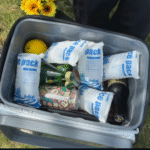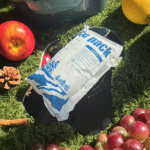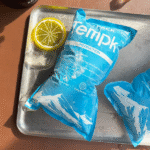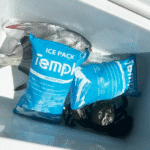Pacotes de gelo seco, comumente usado em indústrias como produtos farmacêuticos, transporte de alimentos, e cadeias de suprimentos médicos, requer cuidados especiais ao descartar deles. Estas formas solidificadas de dióxido de carbono são excepcionalmente frias a temperaturas de -78,5°C (-109.3°F), e o descarte inadequado pode levar a riscos de segurança, como queimaduras pelo frio, asfixia, e contaminação ambiental. Neste guia, você descobrirá instruções passo a passo em como descartar bolsas de gelo seco com segurança, minimizando riscos e protegendo sua saúde e o meio ambiente.
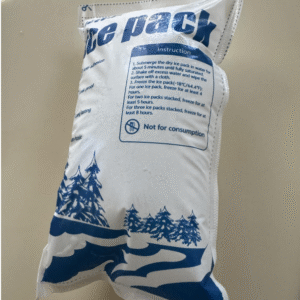
-
Qual é a melhor maneira de descartar bolsas de gelo seco com segurança?
-
Por que o descarte adequado de gelo seco é importante?
-
O gelo seco pode ser jogado fora como lixo normal?
-
O que acontece se você descartar gelo seco de maneira inadequada?
-
Como lidar com sobras de gelo seco após o uso?
Qual é a melhor maneira de descartar bolsas de gelo seco com segurança?
O descarte de gelo seco requer um manuseio cuidadoso e uma compreensão clara das práticas de segurança. O gelo seco sublima em gás dióxido de carbono a -78,5°C. Para descartar gelo seco com segurança, é imprescindível deixá-lo sublimar em local aberto e bem ventilado, onde o gás pode se dispersar inofensivamente. Evite espaços fechados, como sacos de lixo ou salas fechadas, pois representam riscos de aumento perigoso de pressão ou acúmulo de dióxido de carbono.
O método mais seguro envolve mover o gelo seco para fora ou para um espaço bem ventilado, onde pode sublimar sem representar riscos à saúde ou segurança. Uma vez que o gelo seco estiver totalmente sublimado, pode ser descartado sem maiores preocupações.
Por que o descarte adequado de gelo seco é importante?
O descarte inadequado de gelo seco pode resultar em situações perigosas. À medida que o gelo seco sublima, libera gás de dióxido de carbono, que pode deslocar oxigênio em espaços confinados, levando a asfixia. Isto é particularmente perigoso em áreas mal ventiladas, como salas pequenas ou lixeiras fechadas.. Adicionalmente, o contato direto com gelo seco pode causar Frostbite ou danos graves à pele. O descarte adequado garante que o gás escape com segurança e evita o acúmulo prejudicial de pressão, minimizando esses riscos.
Seguindo os procedimentos corretos, você também protege o meio ambiente de quaisquer perigos potenciais associados às emissões descontroladas de CO₂.
Guia passo a passo para descartar gelo seco com segurança
1. Escolha o local de descarte correto
Selecione um aberto, área bem ventilada para descarte, idealmente ao ar livre ou em uma sala grande com fluxo de ar adequado. Certifique-se de que o local permite que o dióxido de carbono sublimado se dissipe naturalmente.
2. Use equipamento de proteção
Sempre manuseie gelo seco com luvas isoladas ou pinças para evitar congelamento. Nunca toque no gelo seco com as mãos desprotegidas, pois o contato prolongado pode causar queimaduras graves ou ferimentos induzidos pelo frio.
3. Permitir que a sublimação ocorra
Deixe o gelo seco em local seguro, área aberta para sublimar naturalmente. Isso pode levar várias horas, dependendo da quantidade de gelo seco. Certifique-se de que a área permaneça ventilada durante esse período para permitir que o gás se dissipe com segurança.
4. Descarte os materiais com segurança
Depois que o gelo seco estiver totalmente sublimado, descarte quaisquer recipientes ou embalagens usadas para armazenar o gelo seco. Siga os regulamentos locais de descarte de resíduos para garantir que os materiais sejam descartados adequadamente.
O que evitar ao descartar gelo seco
-
Não feche o gelo seco em um recipiente hermético: Selar gelo seco em um recipiente pode causar um perigoso acúmulo de pressão, levando a uma explosão.
-
Evite descartar gelo seco dentro de casa: Nunca descarte gelo seco em um espaço confinado, como uma lata de lixo ou sala fechada, pois isso pode causar o acúmulo de gás CO₂, criando um risco de asfixia.
-
Não jogue gelo seco em ralos ou vasos sanitários: Isso pode congelar os canos e causar possíveis problemas de encanamento.
-
Nunca deixe gelo seco sem vigilância em áreas públicas: Isso representa um risco à segurança de outras pessoas que possam entrar em contato com ele sem saber.
Como lidar com sobras de gelo seco após o uso
Se sobrar gelo seco após o uso, a melhor abordagem é deixe-o sublimar naturalmente em um aberto, espaço bem ventilado. Não tente armazenar gelo seco em recipientes fechados, pois isso pode levar a um aumento perigoso de pressão. Evite armazenar gelo seco por longos períodos em ambientes fechados, pois pode apresentar riscos à saúde e ao meio ambiente.
Para pequenas quantidades de gelo seco, um espaço ao ar livre aberto ou perto de uma janela aberta pode servir como um local ideal para permitir que o processo de sublimação ocorra.
Os riscos do descarte inadequado de gelo seco
Asfixia: O gelo seco sublima em gás dióxido de carbono, que pode substituir o oxigênio em espaços fechados. Em áreas mal ventiladas, isso pode causar asfixia ou dificuldades respiratórias.
Frostbite: A exposição direta ao gelo seco pode resultar em ferimentos graves, como congelamento. Sempre use luvas ou pinças ao manuseá-lo para evitar danos à pele.
Aumento de pressão: O descarte de gelo seco em recipientes selados pode causar um perigoso acúmulo de pressão, levando a explosões.
2025 Tendências e inovações no descarte de gelo seco
Visão geral das tendências:
A indústria está mudando para práticas de descarte sustentável Para gelo seco. As empresas estão cada vez mais focadas em reduzindo as emissões de carbono através de alternativas ecológicas de gelo seco, como sistemas de resfriamento à base de nitrogênio. A crescente demanda por soluções ambientalmente conscientes também está impulsionando a inovação nos métodos de manuseio e descarte de gelo seco.
Últimos desenvolvimentos:
-
Alternativas ecológicas: Novas tecnologias estão surgindo para reduzir a pegada ambiental do gelo seco, como refrigerantes à base de nitrogênio.
-
Reciclagem de gelo seco: Algumas empresas estão investigando métodos para reciclar CO₂ sublimado para reutilização em processos industriais.
-
Atualizações regulatórias: Os governos estão endurecendo as regulamentações sobre o descarte de gelo seco, enfatizando práticas mais seguras e sustentáveis.
Perguntas frequentes (Perguntas frequentes)
Q1: Como faço para descartar gelo seco em casa?
Para descartar gelo seco com segurança em casa, simplesmente deixe-o sublimar em um aberto, espaço ventilado como um quintal ou varanda. Evite descartar gelo seco em qualquer área fechada.
Q2: Posso descartar gelo seco no lixo?
Não, gelo seco nunca deve ser descartado no lixo. Deve ser permitido sublimar naturalmente em uma área aberta para evitar aumento perigoso de pressão ou acúmulo de gás.
Resumo e recomendações
Para concluir, o descarte seguro de gelo seco envolve deixá-lo sublimar em um ambiente aberto, área bem ventilada. Certifique-se de que nenhum recipiente hermético seja usado e nunca descarte gelo seco em espaços confinados para evitar riscos potenciais. Sempre use equipamento de proteção adequado para evitar lesões por contato direto com gelo seco. Seguindo estas diretrizes, você minimiza a saúde, ambiental, e riscos de segurança associados ao descarte de gelo seco.
Sobre Tempk
E tempk, somos especializados em segurança, logística eficiente da cadeia de frio e soluções sensíveis à temperatura. Nossa experiência garante que suas remessas sejam tratadas com os mais altos padrões de segurança, minimizando os riscos associados ao descarte de gelo seco. Contate-nos hoje para obter aconselhamento profissional sobre logística de cadeia de frio e manuseio de gelo seco.



















